Business Environment Analysis Report - Business and Environment
VerifiedAdded on 2023/01/12
|18
|5528
|31
Report
AI Summary
This report analyzes the business environment, focusing on Marks and Spencer (M&S) in the United Kingdom. It begins by defining the business environment and outlining different types of organizations, including for-profit, not-for-profit, and non-governmental organizations (NGOs), providing real-world examples for each. The report then explores organizational size and scope, differentiating between micro, small, medium, and large businesses, and examines factors like market share, profit share, and sustainability. It further delves into organizational structures, such as functional, divisional, flat, and matrix structures, with M&S as a case study. The report also includes a SWOT analysis of Tesco and M&S, evaluating their strengths, weaknesses, opportunities, and threats. Finally, it examines the impact of macro and micro factors on business objectives and decision-making, using PESTEL analysis to assess the external environment's influence on the chosen supermarkets.
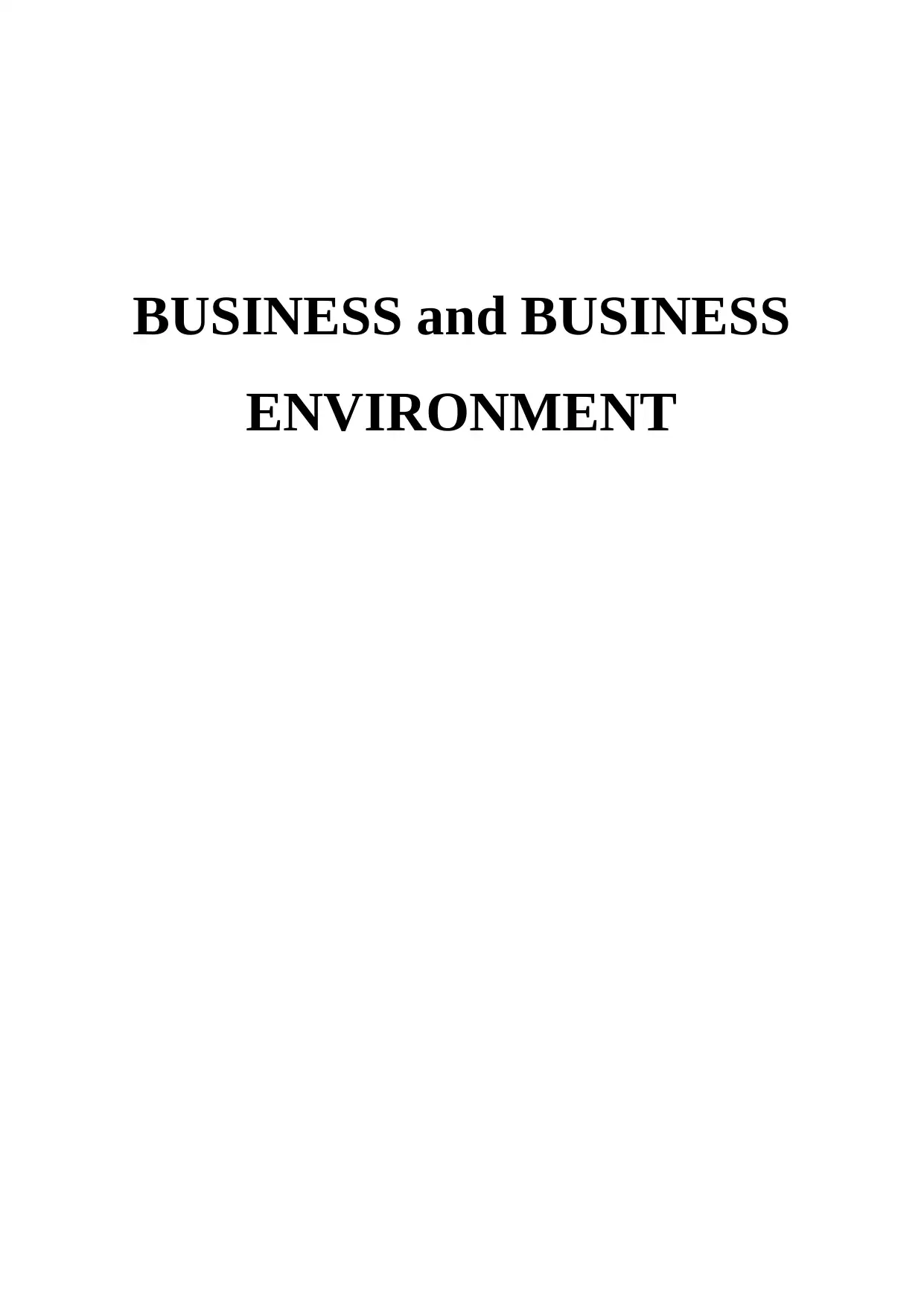
BUSINESS and BUSINESS
ENVIRONMENT
ENVIRONMENT
Paraphrase This Document
Need a fresh take? Get an instant paraphrase of this document with our AI Paraphraser
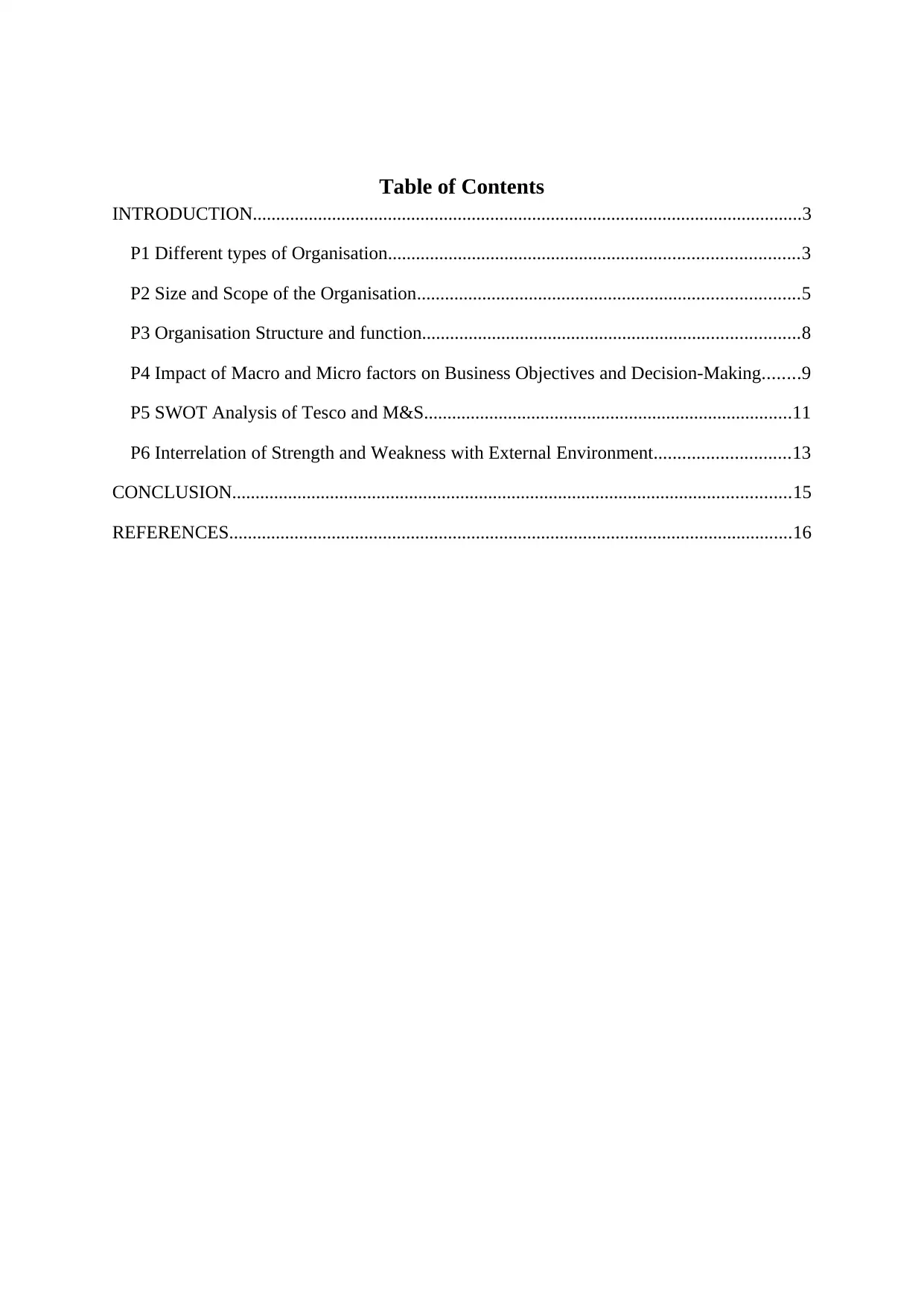
Table of Contents
INTRODUCTION......................................................................................................................3
P1 Different types of Organisation........................................................................................3
P2 Size and Scope of the Organisation..................................................................................5
P3 Organisation Structure and function.................................................................................8
P4 Impact of Macro and Micro factors on Business Objectives and Decision-Making........9
P5 SWOT Analysis of Tesco and M&S...............................................................................11
P6 Interrelation of Strength and Weakness with External Environment.............................13
CONCLUSION........................................................................................................................15
REFERENCES.........................................................................................................................16
INTRODUCTION......................................................................................................................3
P1 Different types of Organisation........................................................................................3
P2 Size and Scope of the Organisation..................................................................................5
P3 Organisation Structure and function.................................................................................8
P4 Impact of Macro and Micro factors on Business Objectives and Decision-Making........9
P5 SWOT Analysis of Tesco and M&S...............................................................................11
P6 Interrelation of Strength and Weakness with External Environment.............................13
CONCLUSION........................................................................................................................15
REFERENCES.........................................................................................................................16
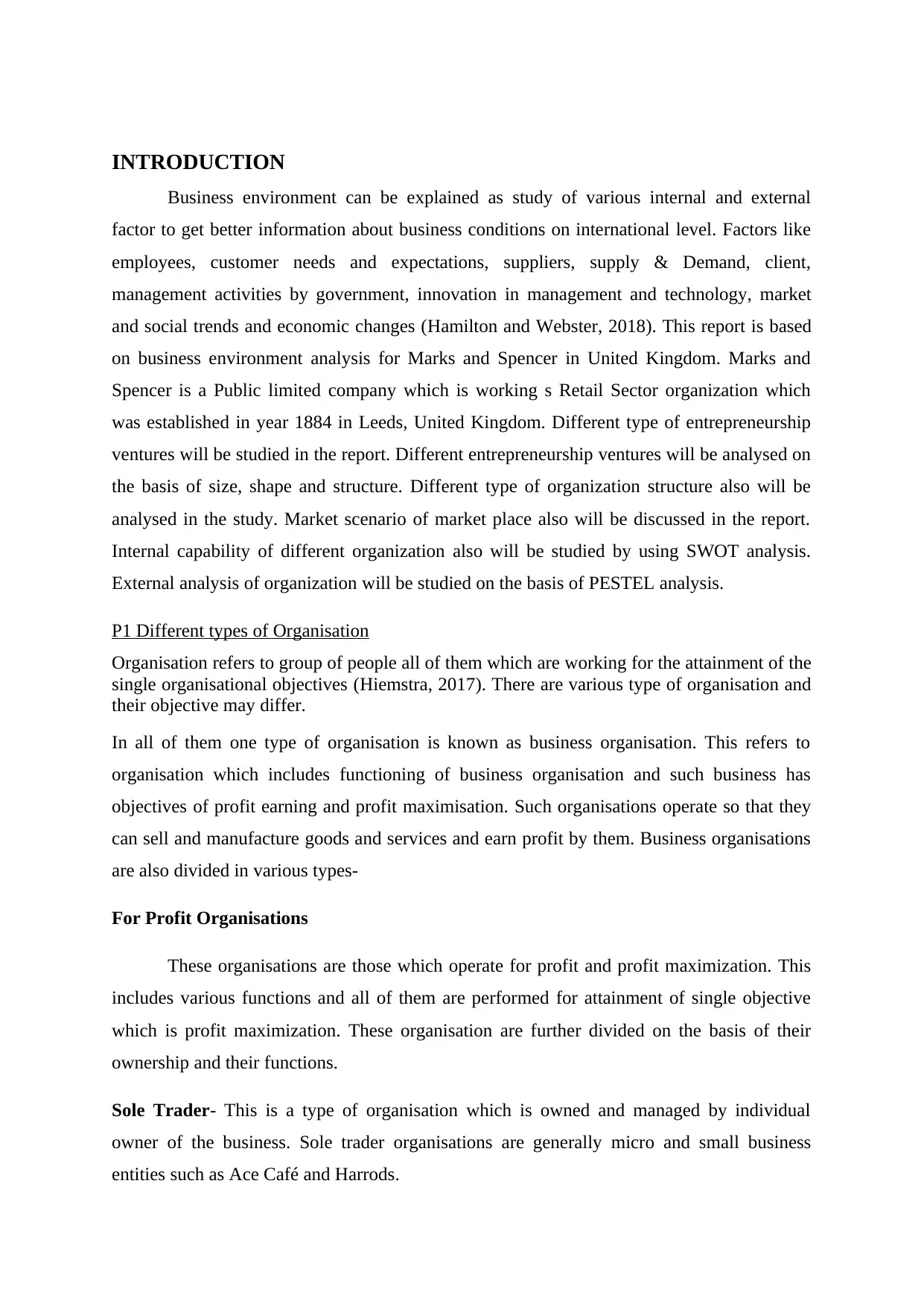
INTRODUCTION
Business environment can be explained as study of various internal and external
factor to get better information about business conditions on international level. Factors like
employees, customer needs and expectations, suppliers, supply & Demand, client,
management activities by government, innovation in management and technology, market
and social trends and economic changes (Hamilton and Webster, 2018). This report is based
on business environment analysis for Marks and Spencer in United Kingdom. Marks and
Spencer is a Public limited company which is working s Retail Sector organization which
was established in year 1884 in Leeds, United Kingdom. Different type of entrepreneurship
ventures will be studied in the report. Different entrepreneurship ventures will be analysed on
the basis of size, shape and structure. Different type of organization structure also will be
analysed in the study. Market scenario of market place also will be discussed in the report.
Internal capability of different organization also will be studied by using SWOT analysis.
External analysis of organization will be studied on the basis of PESTEL analysis.
P1 Different types of Organisation
Organisation refers to group of people all of them which are working for the attainment of the
single organisational objectives (Hiemstra, 2017). There are various type of organisation and
their objective may differ.
In all of them one type of organisation is known as business organisation. This refers to
organisation which includes functioning of business organisation and such business has
objectives of profit earning and profit maximisation. Such organisations operate so that they
can sell and manufacture goods and services and earn profit by them. Business organisations
are also divided in various types-
For Profit Organisations
These organisations are those which operate for profit and profit maximization. This
includes various functions and all of them are performed for attainment of single objective
which is profit maximization. These organisation are further divided on the basis of their
ownership and their functions.
Sole Trader- This is a type of organisation which is owned and managed by individual
owner of the business. Sole trader organisations are generally micro and small business
entities such as Ace Café and Harrods.
Business environment can be explained as study of various internal and external
factor to get better information about business conditions on international level. Factors like
employees, customer needs and expectations, suppliers, supply & Demand, client,
management activities by government, innovation in management and technology, market
and social trends and economic changes (Hamilton and Webster, 2018). This report is based
on business environment analysis for Marks and Spencer in United Kingdom. Marks and
Spencer is a Public limited company which is working s Retail Sector organization which
was established in year 1884 in Leeds, United Kingdom. Different type of entrepreneurship
ventures will be studied in the report. Different entrepreneurship ventures will be analysed on
the basis of size, shape and structure. Different type of organization structure also will be
analysed in the study. Market scenario of market place also will be discussed in the report.
Internal capability of different organization also will be studied by using SWOT analysis.
External analysis of organization will be studied on the basis of PESTEL analysis.
P1 Different types of Organisation
Organisation refers to group of people all of them which are working for the attainment of the
single organisational objectives (Hiemstra, 2017). There are various type of organisation and
their objective may differ.
In all of them one type of organisation is known as business organisation. This refers to
organisation which includes functioning of business organisation and such business has
objectives of profit earning and profit maximisation. Such organisations operate so that they
can sell and manufacture goods and services and earn profit by them. Business organisations
are also divided in various types-
For Profit Organisations
These organisations are those which operate for profit and profit maximization. This
includes various functions and all of them are performed for attainment of single objective
which is profit maximization. These organisation are further divided on the basis of their
ownership and their functions.
Sole Trader- This is a type of organisation which is owned and managed by individual
owner of the business. Sole trader organisations are generally micro and small business
entities such as Ace Café and Harrods.
⊘ This is a preview!⊘
Do you want full access?
Subscribe today to unlock all pages.

Trusted by 1+ million students worldwide
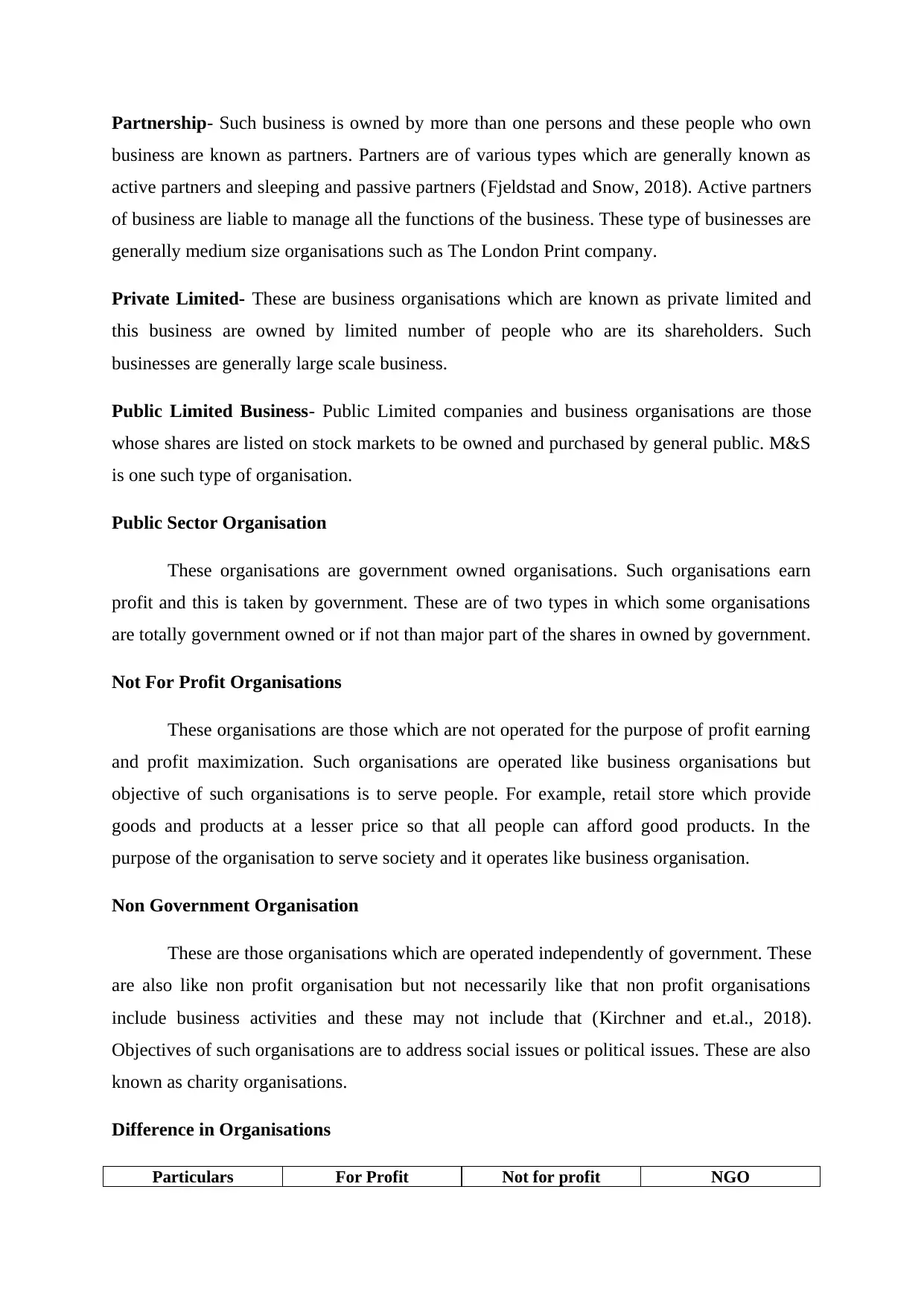
Partnership- Such business is owned by more than one persons and these people who own
business are known as partners. Partners are of various types which are generally known as
active partners and sleeping and passive partners (Fjeldstad and Snow, 2018). Active partners
of business are liable to manage all the functions of the business. These type of businesses are
generally medium size organisations such as The London Print company.
Private Limited- These are business organisations which are known as private limited and
this business are owned by limited number of people who are its shareholders. Such
businesses are generally large scale business.
Public Limited Business- Public Limited companies and business organisations are those
whose shares are listed on stock markets to be owned and purchased by general public. M&S
is one such type of organisation.
Public Sector Organisation
These organisations are government owned organisations. Such organisations earn
profit and this is taken by government. These are of two types in which some organisations
are totally government owned or if not than major part of the shares in owned by government.
Not For Profit Organisations
These organisations are those which are not operated for the purpose of profit earning
and profit maximization. Such organisations are operated like business organisations but
objective of such organisations is to serve people. For example, retail store which provide
goods and products at a lesser price so that all people can afford good products. In the
purpose of the organisation to serve society and it operates like business organisation.
Non Government Organisation
These are those organisations which are operated independently of government. These
are also like non profit organisation but not necessarily like that non profit organisations
include business activities and these may not include that (Kirchner and et.al., 2018).
Objectives of such organisations are to address social issues or political issues. These are also
known as charity organisations.
Difference in Organisations
Particulars For Profit Not for profit NGO
business are known as partners. Partners are of various types which are generally known as
active partners and sleeping and passive partners (Fjeldstad and Snow, 2018). Active partners
of business are liable to manage all the functions of the business. These type of businesses are
generally medium size organisations such as The London Print company.
Private Limited- These are business organisations which are known as private limited and
this business are owned by limited number of people who are its shareholders. Such
businesses are generally large scale business.
Public Limited Business- Public Limited companies and business organisations are those
whose shares are listed on stock markets to be owned and purchased by general public. M&S
is one such type of organisation.
Public Sector Organisation
These organisations are government owned organisations. Such organisations earn
profit and this is taken by government. These are of two types in which some organisations
are totally government owned or if not than major part of the shares in owned by government.
Not For Profit Organisations
These organisations are those which are not operated for the purpose of profit earning
and profit maximization. Such organisations are operated like business organisations but
objective of such organisations is to serve people. For example, retail store which provide
goods and products at a lesser price so that all people can afford good products. In the
purpose of the organisation to serve society and it operates like business organisation.
Non Government Organisation
These are those organisations which are operated independently of government. These
are also like non profit organisation but not necessarily like that non profit organisations
include business activities and these may not include that (Kirchner and et.al., 2018).
Objectives of such organisations are to address social issues or political issues. These are also
known as charity organisations.
Difference in Organisations
Particulars For Profit Not for profit NGO
Paraphrase This Document
Need a fresh take? Get an instant paraphrase of this document with our AI Paraphraser
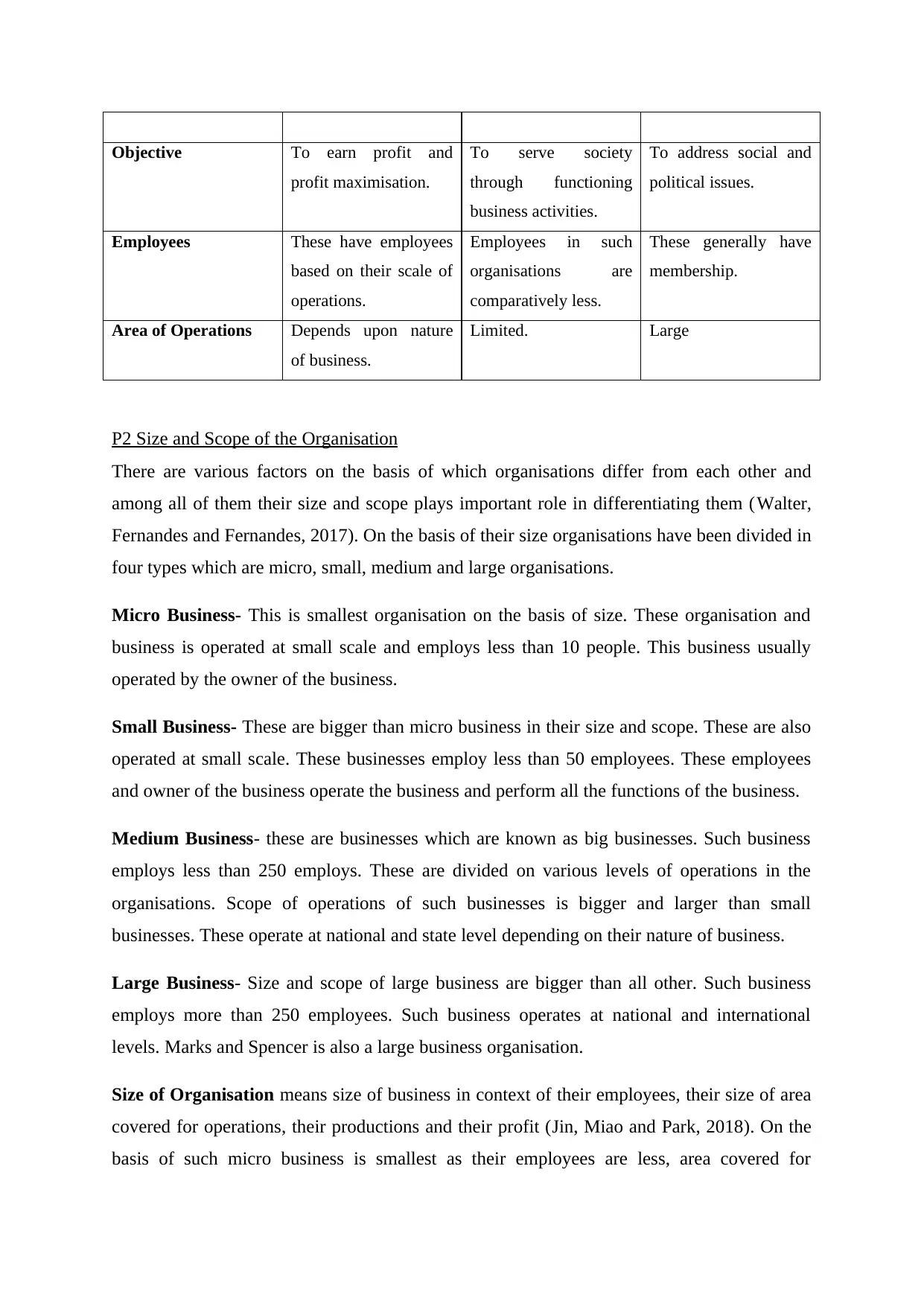
Objective To earn profit and
profit maximisation.
To serve society
through functioning
business activities.
To address social and
political issues.
Employees These have employees
based on their scale of
operations.
Employees in such
organisations are
comparatively less.
These generally have
membership.
Area of Operations Depends upon nature
of business.
Limited. Large
P2 Size and Scope of the Organisation
There are various factors on the basis of which organisations differ from each other and
among all of them their size and scope plays important role in differentiating them (Walter,
Fernandes and Fernandes, 2017). On the basis of their size organisations have been divided in
four types which are micro, small, medium and large organisations.
Micro Business- This is smallest organisation on the basis of size. These organisation and
business is operated at small scale and employs less than 10 people. This business usually
operated by the owner of the business.
Small Business- These are bigger than micro business in their size and scope. These are also
operated at small scale. These businesses employ less than 50 employees. These employees
and owner of the business operate the business and perform all the functions of the business.
Medium Business- these are businesses which are known as big businesses. Such business
employs less than 250 employs. These are divided on various levels of operations in the
organisations. Scope of operations of such businesses is bigger and larger than small
businesses. These operate at national and state level depending on their nature of business.
Large Business- Size and scope of large business are bigger than all other. Such business
employs more than 250 employees. Such business operates at national and international
levels. Marks and Spencer is also a large business organisation.
Size of Organisation means size of business in context of their employees, their size of area
covered for operations, their productions and their profit (Jin, Miao and Park, 2018). On the
basis of such micro business is smallest as their employees are less, area covered for
profit maximisation.
To serve society
through functioning
business activities.
To address social and
political issues.
Employees These have employees
based on their scale of
operations.
Employees in such
organisations are
comparatively less.
These generally have
membership.
Area of Operations Depends upon nature
of business.
Limited. Large
P2 Size and Scope of the Organisation
There are various factors on the basis of which organisations differ from each other and
among all of them their size and scope plays important role in differentiating them (Walter,
Fernandes and Fernandes, 2017). On the basis of their size organisations have been divided in
four types which are micro, small, medium and large organisations.
Micro Business- This is smallest organisation on the basis of size. These organisation and
business is operated at small scale and employs less than 10 people. This business usually
operated by the owner of the business.
Small Business- These are bigger than micro business in their size and scope. These are also
operated at small scale. These businesses employ less than 50 employees. These employees
and owner of the business operate the business and perform all the functions of the business.
Medium Business- these are businesses which are known as big businesses. Such business
employs less than 250 employs. These are divided on various levels of operations in the
organisations. Scope of operations of such businesses is bigger and larger than small
businesses. These operate at national and state level depending on their nature of business.
Large Business- Size and scope of large business are bigger than all other. Such business
employs more than 250 employees. Such business operates at national and international
levels. Marks and Spencer is also a large business organisation.
Size of Organisation means size of business in context of their employees, their size of area
covered for operations, their productions and their profit (Jin, Miao and Park, 2018). On the
basis of such micro business is smallest as their employees are less, area covered for
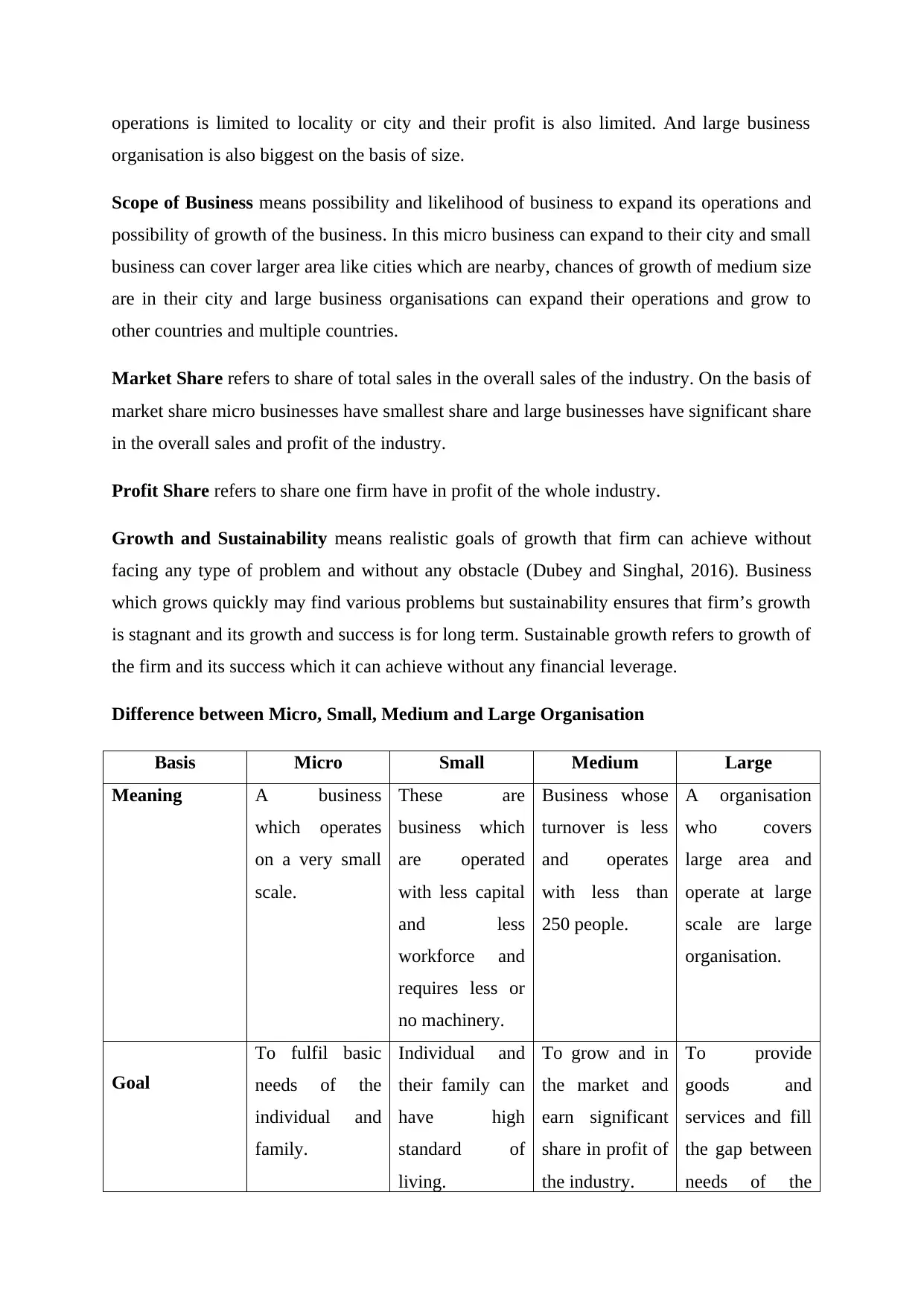
operations is limited to locality or city and their profit is also limited. And large business
organisation is also biggest on the basis of size.
Scope of Business means possibility and likelihood of business to expand its operations and
possibility of growth of the business. In this micro business can expand to their city and small
business can cover larger area like cities which are nearby, chances of growth of medium size
are in their city and large business organisations can expand their operations and grow to
other countries and multiple countries.
Market Share refers to share of total sales in the overall sales of the industry. On the basis of
market share micro businesses have smallest share and large businesses have significant share
in the overall sales and profit of the industry.
Profit Share refers to share one firm have in profit of the whole industry.
Growth and Sustainability means realistic goals of growth that firm can achieve without
facing any type of problem and without any obstacle (Dubey and Singhal, 2016). Business
which grows quickly may find various problems but sustainability ensures that firm’s growth
is stagnant and its growth and success is for long term. Sustainable growth refers to growth of
the firm and its success which it can achieve without any financial leverage.
Difference between Micro, Small, Medium and Large Organisation
Basis Micro Small Medium Large
Meaning A business
which operates
on a very small
scale.
These are
business which
are operated
with less capital
and less
workforce and
requires less or
no machinery.
Business whose
turnover is less
and operates
with less than
250 people.
A organisation
who covers
large area and
operate at large
scale are large
organisation.
Goal
To fulfil basic
needs of the
individual and
family.
Individual and
their family can
have high
standard of
living.
To grow and in
the market and
earn significant
share in profit of
the industry.
To provide
goods and
services and fill
the gap between
needs of the
organisation is also biggest on the basis of size.
Scope of Business means possibility and likelihood of business to expand its operations and
possibility of growth of the business. In this micro business can expand to their city and small
business can cover larger area like cities which are nearby, chances of growth of medium size
are in their city and large business organisations can expand their operations and grow to
other countries and multiple countries.
Market Share refers to share of total sales in the overall sales of the industry. On the basis of
market share micro businesses have smallest share and large businesses have significant share
in the overall sales and profit of the industry.
Profit Share refers to share one firm have in profit of the whole industry.
Growth and Sustainability means realistic goals of growth that firm can achieve without
facing any type of problem and without any obstacle (Dubey and Singhal, 2016). Business
which grows quickly may find various problems but sustainability ensures that firm’s growth
is stagnant and its growth and success is for long term. Sustainable growth refers to growth of
the firm and its success which it can achieve without any financial leverage.
Difference between Micro, Small, Medium and Large Organisation
Basis Micro Small Medium Large
Meaning A business
which operates
on a very small
scale.
These are
business which
are operated
with less capital
and less
workforce and
requires less or
no machinery.
Business whose
turnover is less
and operates
with less than
250 people.
A organisation
who covers
large area and
operate at large
scale are large
organisation.
Goal
To fulfil basic
needs of the
individual and
family.
Individual and
their family can
have high
standard of
living.
To grow and in
the market and
earn significant
share in profit of
the industry.
To provide
goods and
services and fill
the gap between
needs of the
⊘ This is a preview!⊘
Do you want full access?
Subscribe today to unlock all pages.

Trusted by 1+ million students worldwide
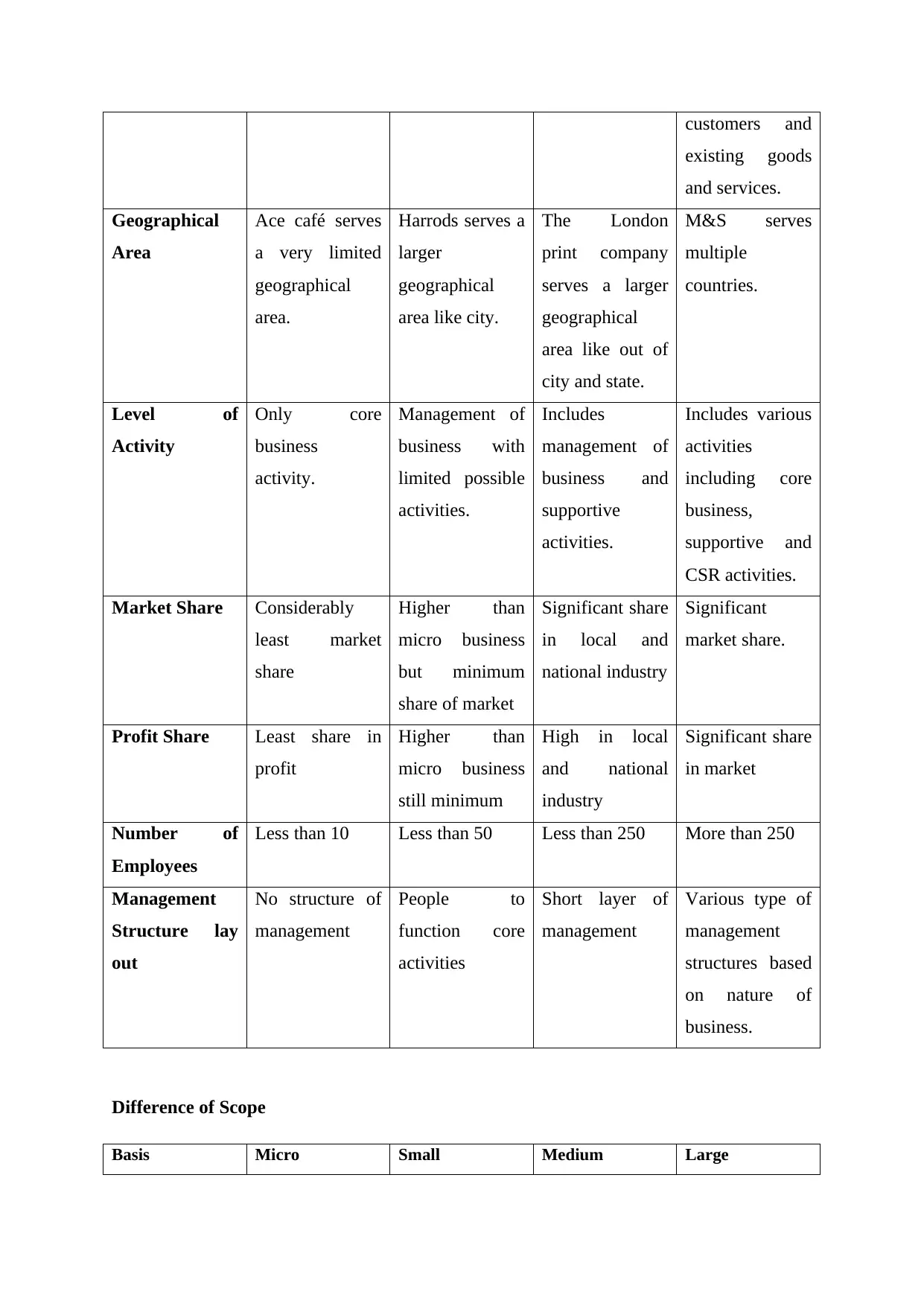
customers and
existing goods
and services.
Geographical
Area
Ace café serves
a very limited
geographical
area.
Harrods serves a
larger
geographical
area like city.
The London
print company
serves a larger
geographical
area like out of
city and state.
M&S serves
multiple
countries.
Level of
Activity
Only core
business
activity.
Management of
business with
limited possible
activities.
Includes
management of
business and
supportive
activities.
Includes various
activities
including core
business,
supportive and
CSR activities.
Market Share Considerably
least market
share
Higher than
micro business
but minimum
share of market
Significant share
in local and
national industry
Significant
market share.
Profit Share Least share in
profit
Higher than
micro business
still minimum
High in local
and national
industry
Significant share
in market
Number of
Employees
Less than 10 Less than 50 Less than 250 More than 250
Management
Structure lay
out
No structure of
management
People to
function core
activities
Short layer of
management
Various type of
management
structures based
on nature of
business.
Difference of Scope
Basis Micro Small Medium Large
existing goods
and services.
Geographical
Area
Ace café serves
a very limited
geographical
area.
Harrods serves a
larger
geographical
area like city.
The London
print company
serves a larger
geographical
area like out of
city and state.
M&S serves
multiple
countries.
Level of
Activity
Only core
business
activity.
Management of
business with
limited possible
activities.
Includes
management of
business and
supportive
activities.
Includes various
activities
including core
business,
supportive and
CSR activities.
Market Share Considerably
least market
share
Higher than
micro business
but minimum
share of market
Significant share
in local and
national industry
Significant
market share.
Profit Share Least share in
profit
Higher than
micro business
still minimum
High in local
and national
industry
Significant share
in market
Number of
Employees
Less than 10 Less than 50 Less than 250 More than 250
Management
Structure lay
out
No structure of
management
People to
function core
activities
Short layer of
management
Various type of
management
structures based
on nature of
business.
Difference of Scope
Basis Micro Small Medium Large
Paraphrase This Document
Need a fresh take? Get an instant paraphrase of this document with our AI Paraphraser
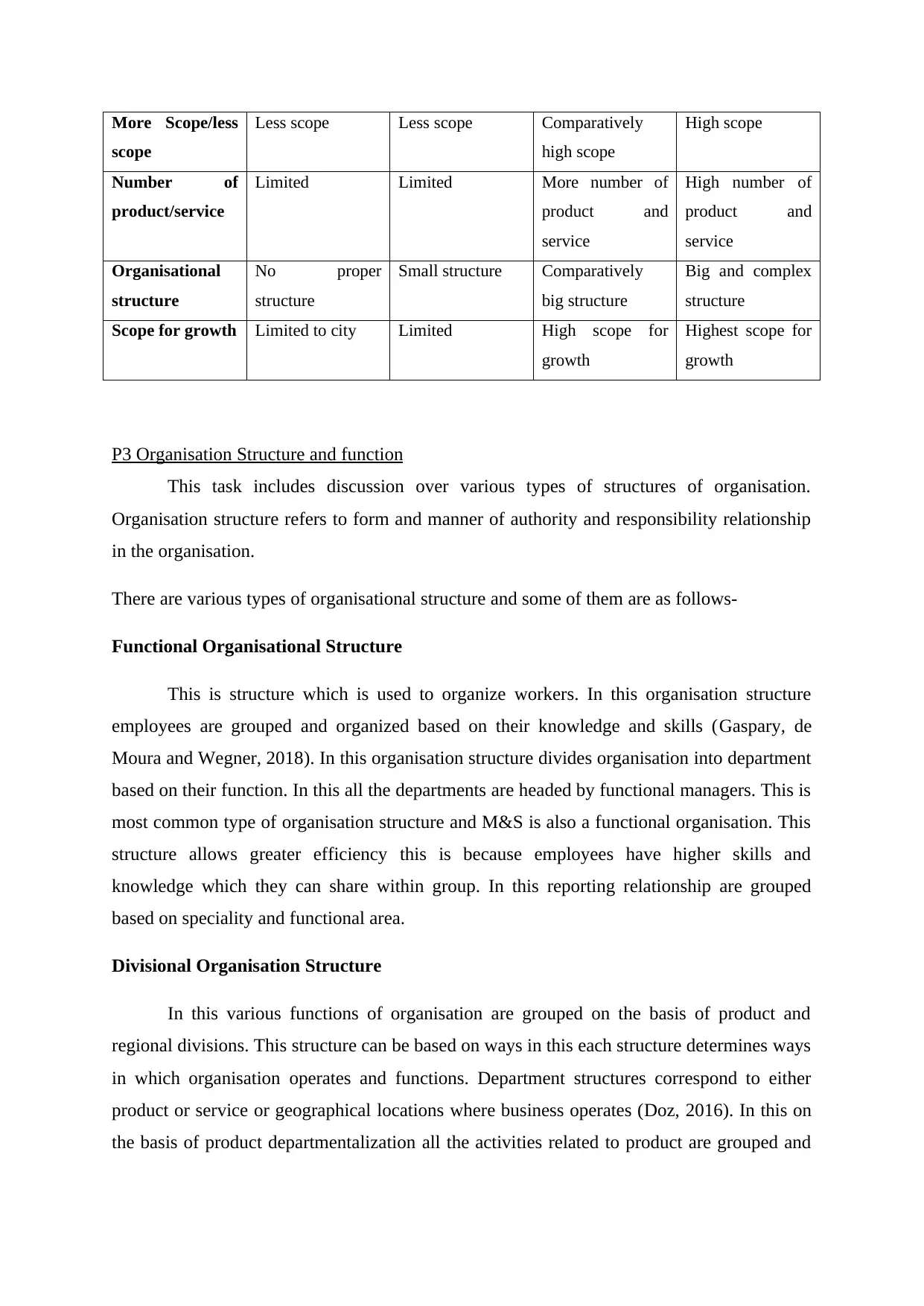
More Scope/less
scope
Less scope Less scope Comparatively
high scope
High scope
Number of
product/service
Limited Limited More number of
product and
service
High number of
product and
service
Organisational
structure
No proper
structure
Small structure Comparatively
big structure
Big and complex
structure
Scope for growth Limited to city Limited High scope for
growth
Highest scope for
growth
P3 Organisation Structure and function
This task includes discussion over various types of structures of organisation.
Organisation structure refers to form and manner of authority and responsibility relationship
in the organisation.
There are various types of organisational structure and some of them are as follows-
Functional Organisational Structure
This is structure which is used to organize workers. In this organisation structure
employees are grouped and organized based on their knowledge and skills (Gaspary, de
Moura and Wegner, 2018). In this organisation structure divides organisation into department
based on their function. In this all the departments are headed by functional managers. This is
most common type of organisation structure and M&S is also a functional organisation. This
structure allows greater efficiency this is because employees have higher skills and
knowledge which they can share within group. In this reporting relationship are grouped
based on speciality and functional area.
Divisional Organisation Structure
In this various functions of organisation are grouped on the basis of product and
regional divisions. This structure can be based on ways in this each structure determines ways
in which organisation operates and functions. Department structures correspond to either
product or service or geographical locations where business operates (Doz, 2016). In this on
the basis of product departmentalization all the activities related to product are grouped and
scope
Less scope Less scope Comparatively
high scope
High scope
Number of
product/service
Limited Limited More number of
product and
service
High number of
product and
service
Organisational
structure
No proper
structure
Small structure Comparatively
big structure
Big and complex
structure
Scope for growth Limited to city Limited High scope for
growth
Highest scope for
growth
P3 Organisation Structure and function
This task includes discussion over various types of structures of organisation.
Organisation structure refers to form and manner of authority and responsibility relationship
in the organisation.
There are various types of organisational structure and some of them are as follows-
Functional Organisational Structure
This is structure which is used to organize workers. In this organisation structure
employees are grouped and organized based on their knowledge and skills (Gaspary, de
Moura and Wegner, 2018). In this organisation structure divides organisation into department
based on their function. In this all the departments are headed by functional managers. This is
most common type of organisation structure and M&S is also a functional organisation. This
structure allows greater efficiency this is because employees have higher skills and
knowledge which they can share within group. In this reporting relationship are grouped
based on speciality and functional area.
Divisional Organisation Structure
In this various functions of organisation are grouped on the basis of product and
regional divisions. This structure can be based on ways in this each structure determines ways
in which organisation operates and functions. Department structures correspond to either
product or service or geographical locations where business operates (Doz, 2016). In this on
the basis of product departmentalization all the activities related to product are grouped and
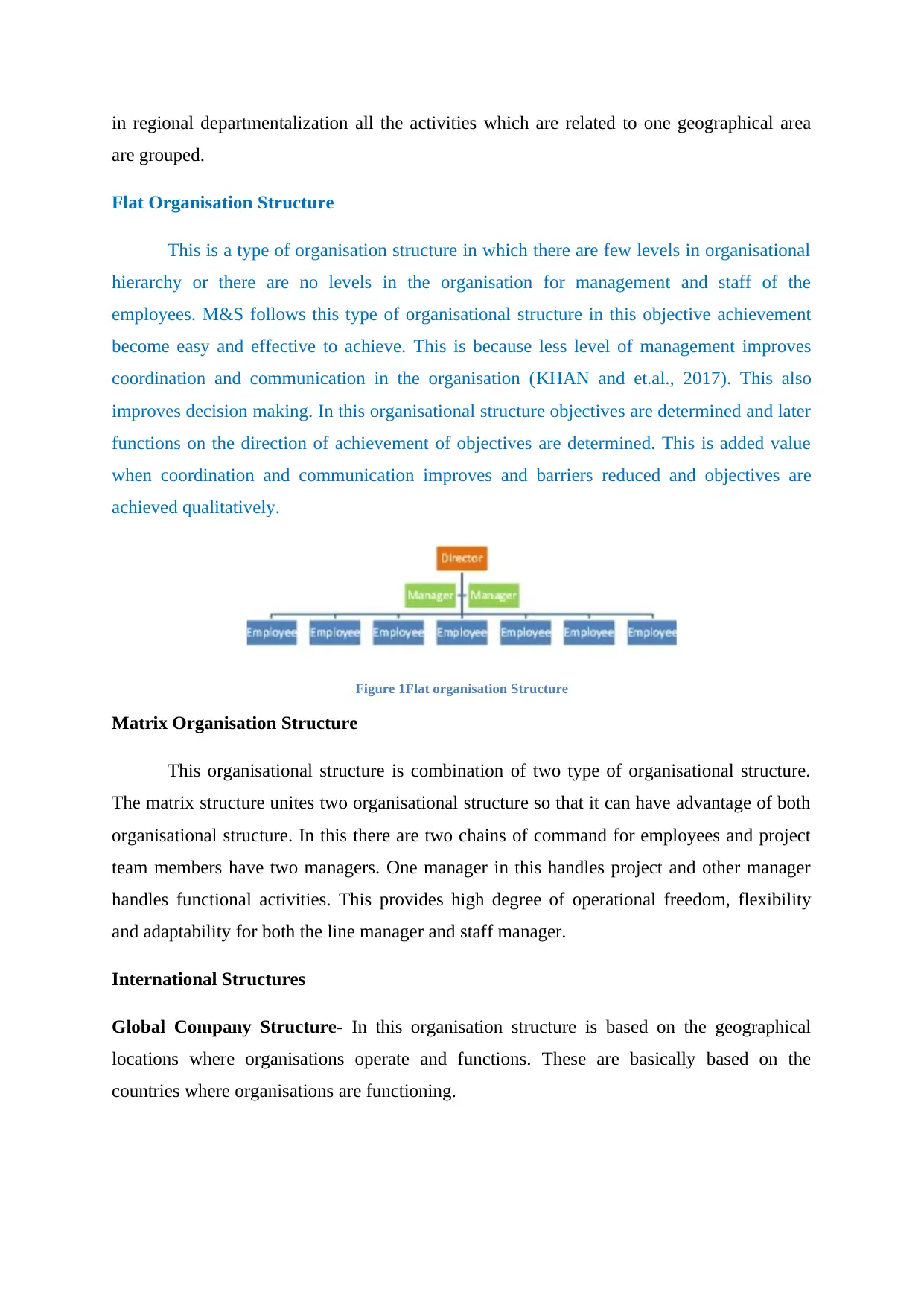
in regional departmentalization all the activities which are related to one geographical area
are grouped.
Flat Organisation Structure
This is a type of organisation structure in which there are few levels in organisational
hierarchy or there are no levels in the organisation for management and staff of the
employees. M&S follows this type of organisational structure in this objective achievement
become easy and effective to achieve. This is because less level of management improves
coordination and communication in the organisation (KHAN and et.al., 2017). This also
improves decision making. In this organisational structure objectives are determined and later
functions on the direction of achievement of objectives are determined. This is added value
when coordination and communication improves and barriers reduced and objectives are
achieved qualitatively.
Figure 1Flat organisation Structure
Matrix Organisation Structure
This organisational structure is combination of two type of organisational structure.
The matrix structure unites two organisational structure so that it can have advantage of both
organisational structure. In this there are two chains of command for employees and project
team members have two managers. One manager in this handles project and other manager
handles functional activities. This provides high degree of operational freedom, flexibility
and adaptability for both the line manager and staff manager.
International Structures
Global Company Structure- In this organisation structure is based on the geographical
locations where organisations operate and functions. These are basically based on the
countries where organisations are functioning.
are grouped.
Flat Organisation Structure
This is a type of organisation structure in which there are few levels in organisational
hierarchy or there are no levels in the organisation for management and staff of the
employees. M&S follows this type of organisational structure in this objective achievement
become easy and effective to achieve. This is because less level of management improves
coordination and communication in the organisation (KHAN and et.al., 2017). This also
improves decision making. In this organisational structure objectives are determined and later
functions on the direction of achievement of objectives are determined. This is added value
when coordination and communication improves and barriers reduced and objectives are
achieved qualitatively.
Figure 1Flat organisation Structure
Matrix Organisation Structure
This organisational structure is combination of two type of organisational structure.
The matrix structure unites two organisational structure so that it can have advantage of both
organisational structure. In this there are two chains of command for employees and project
team members have two managers. One manager in this handles project and other manager
handles functional activities. This provides high degree of operational freedom, flexibility
and adaptability for both the line manager and staff manager.
International Structures
Global Company Structure- In this organisation structure is based on the geographical
locations where organisations operate and functions. These are basically based on the
countries where organisations are functioning.
⊘ This is a preview!⊘
Do you want full access?
Subscribe today to unlock all pages.

Trusted by 1+ million students worldwide
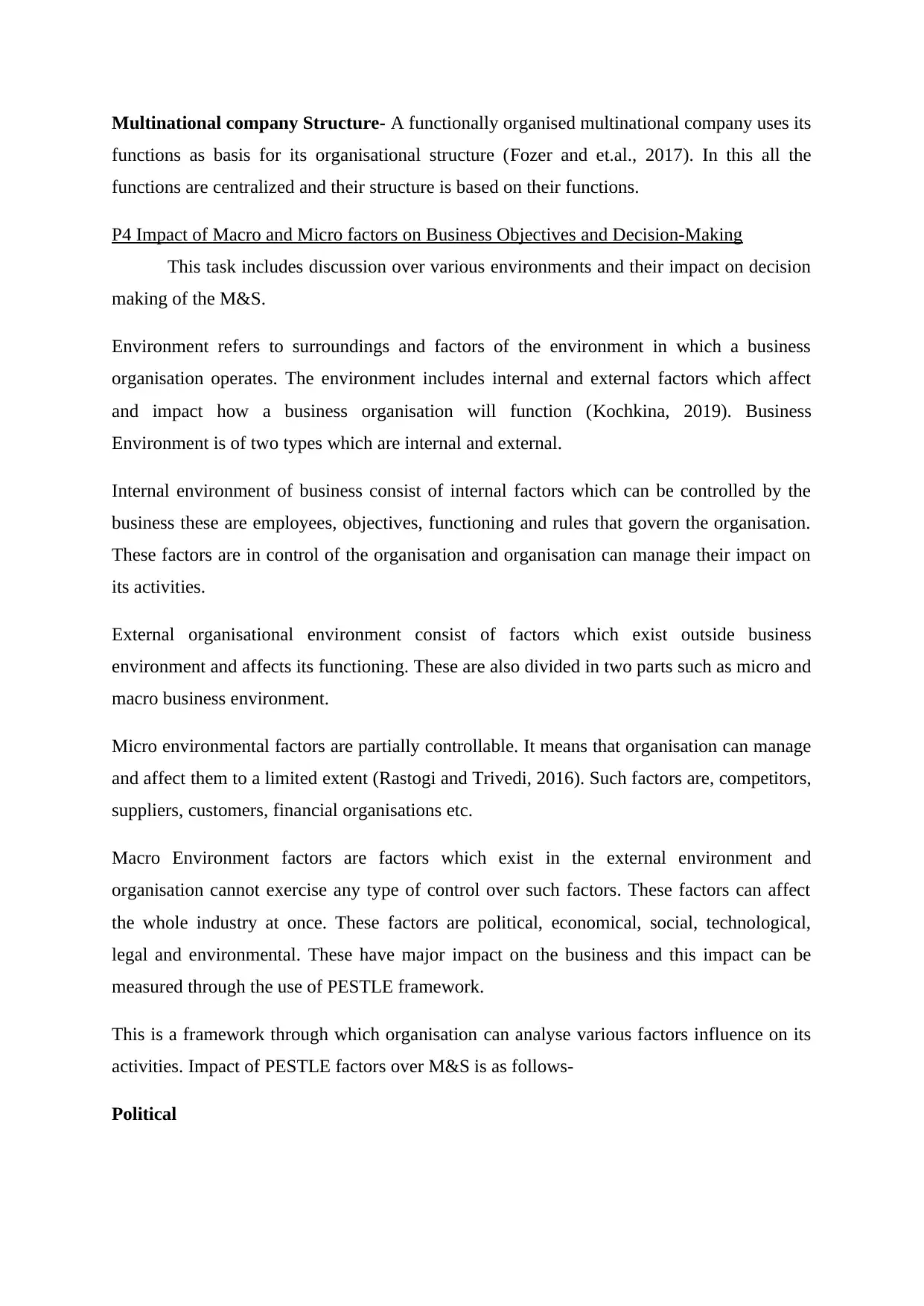
Multinational company Structure- A functionally organised multinational company uses its
functions as basis for its organisational structure (Fozer and et.al., 2017). In this all the
functions are centralized and their structure is based on their functions.
P4 Impact of Macro and Micro factors on Business Objectives and Decision-Making
This task includes discussion over various environments and their impact on decision
making of the M&S.
Environment refers to surroundings and factors of the environment in which a business
organisation operates. The environment includes internal and external factors which affect
and impact how a business organisation will function (Kochkina, 2019). Business
Environment is of two types which are internal and external.
Internal environment of business consist of internal factors which can be controlled by the
business these are employees, objectives, functioning and rules that govern the organisation.
These factors are in control of the organisation and organisation can manage their impact on
its activities.
External organisational environment consist of factors which exist outside business
environment and affects its functioning. These are also divided in two parts such as micro and
macro business environment.
Micro environmental factors are partially controllable. It means that organisation can manage
and affect them to a limited extent (Rastogi and Trivedi, 2016). Such factors are, competitors,
suppliers, customers, financial organisations etc.
Macro Environment factors are factors which exist in the external environment and
organisation cannot exercise any type of control over such factors. These factors can affect
the whole industry at once. These factors are political, economical, social, technological,
legal and environmental. These have major impact on the business and this impact can be
measured through the use of PESTLE framework.
This is a framework through which organisation can analyse various factors influence on its
activities. Impact of PESTLE factors over M&S is as follows-
Political
functions as basis for its organisational structure (Fozer and et.al., 2017). In this all the
functions are centralized and their structure is based on their functions.
P4 Impact of Macro and Micro factors on Business Objectives and Decision-Making
This task includes discussion over various environments and their impact on decision
making of the M&S.
Environment refers to surroundings and factors of the environment in which a business
organisation operates. The environment includes internal and external factors which affect
and impact how a business organisation will function (Kochkina, 2019). Business
Environment is of two types which are internal and external.
Internal environment of business consist of internal factors which can be controlled by the
business these are employees, objectives, functioning and rules that govern the organisation.
These factors are in control of the organisation and organisation can manage their impact on
its activities.
External organisational environment consist of factors which exist outside business
environment and affects its functioning. These are also divided in two parts such as micro and
macro business environment.
Micro environmental factors are partially controllable. It means that organisation can manage
and affect them to a limited extent (Rastogi and Trivedi, 2016). Such factors are, competitors,
suppliers, customers, financial organisations etc.
Macro Environment factors are factors which exist in the external environment and
organisation cannot exercise any type of control over such factors. These factors can affect
the whole industry at once. These factors are political, economical, social, technological,
legal and environmental. These have major impact on the business and this impact can be
measured through the use of PESTLE framework.
This is a framework through which organisation can analyse various factors influence on its
activities. Impact of PESTLE factors over M&S is as follows-
Political
Paraphrase This Document
Need a fresh take? Get an instant paraphrase of this document with our AI Paraphraser
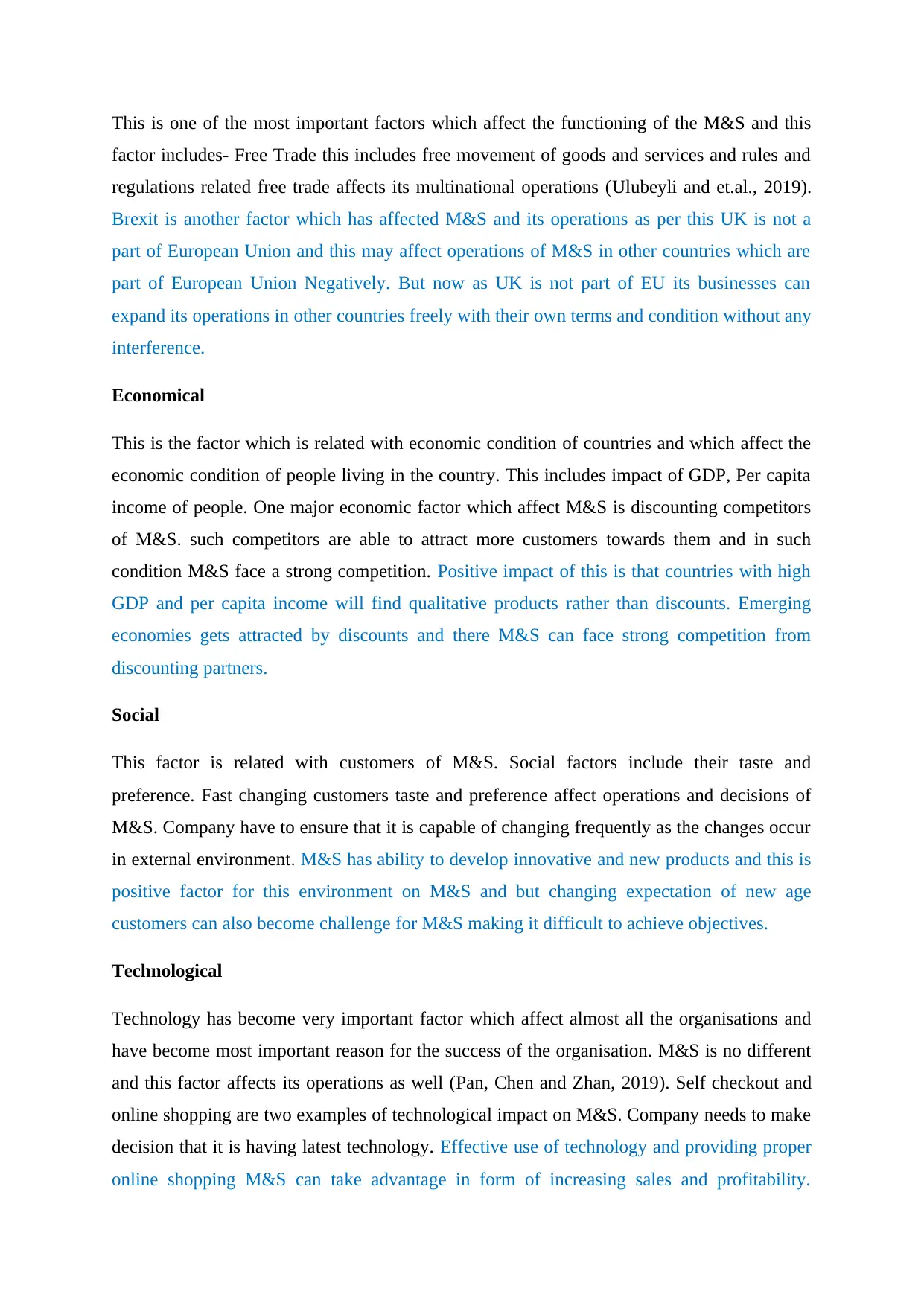
This is one of the most important factors which affect the functioning of the M&S and this
factor includes- Free Trade this includes free movement of goods and services and rules and
regulations related free trade affects its multinational operations (Ulubeyli and et.al., 2019).
Brexit is another factor which has affected M&S and its operations as per this UK is not a
part of European Union and this may affect operations of M&S in other countries which are
part of European Union Negatively. But now as UK is not part of EU its businesses can
expand its operations in other countries freely with their own terms and condition without any
interference.
Economical
This is the factor which is related with economic condition of countries and which affect the
economic condition of people living in the country. This includes impact of GDP, Per capita
income of people. One major economic factor which affect M&S is discounting competitors
of M&S. such competitors are able to attract more customers towards them and in such
condition M&S face a strong competition. Positive impact of this is that countries with high
GDP and per capita income will find qualitative products rather than discounts. Emerging
economies gets attracted by discounts and there M&S can face strong competition from
discounting partners.
Social
This factor is related with customers of M&S. Social factors include their taste and
preference. Fast changing customers taste and preference affect operations and decisions of
M&S. Company have to ensure that it is capable of changing frequently as the changes occur
in external environment. M&S has ability to develop innovative and new products and this is
positive factor for this environment on M&S and but changing expectation of new age
customers can also become challenge for M&S making it difficult to achieve objectives.
Technological
Technology has become very important factor which affect almost all the organisations and
have become most important reason for the success of the organisation. M&S is no different
and this factor affects its operations as well (Pan, Chen and Zhan, 2019). Self checkout and
online shopping are two examples of technological impact on M&S. Company needs to make
decision that it is having latest technology. Effective use of technology and providing proper
online shopping M&S can take advantage in form of increasing sales and profitability.
factor includes- Free Trade this includes free movement of goods and services and rules and
regulations related free trade affects its multinational operations (Ulubeyli and et.al., 2019).
Brexit is another factor which has affected M&S and its operations as per this UK is not a
part of European Union and this may affect operations of M&S in other countries which are
part of European Union Negatively. But now as UK is not part of EU its businesses can
expand its operations in other countries freely with their own terms and condition without any
interference.
Economical
This is the factor which is related with economic condition of countries and which affect the
economic condition of people living in the country. This includes impact of GDP, Per capita
income of people. One major economic factor which affect M&S is discounting competitors
of M&S. such competitors are able to attract more customers towards them and in such
condition M&S face a strong competition. Positive impact of this is that countries with high
GDP and per capita income will find qualitative products rather than discounts. Emerging
economies gets attracted by discounts and there M&S can face strong competition from
discounting partners.
Social
This factor is related with customers of M&S. Social factors include their taste and
preference. Fast changing customers taste and preference affect operations and decisions of
M&S. Company have to ensure that it is capable of changing frequently as the changes occur
in external environment. M&S has ability to develop innovative and new products and this is
positive factor for this environment on M&S and but changing expectation of new age
customers can also become challenge for M&S making it difficult to achieve objectives.
Technological
Technology has become very important factor which affect almost all the organisations and
have become most important reason for the success of the organisation. M&S is no different
and this factor affects its operations as well (Pan, Chen and Zhan, 2019). Self checkout and
online shopping are two examples of technological impact on M&S. Company needs to make
decision that it is having latest technology. Effective use of technology and providing proper
online shopping M&S can take advantage in form of increasing sales and profitability.
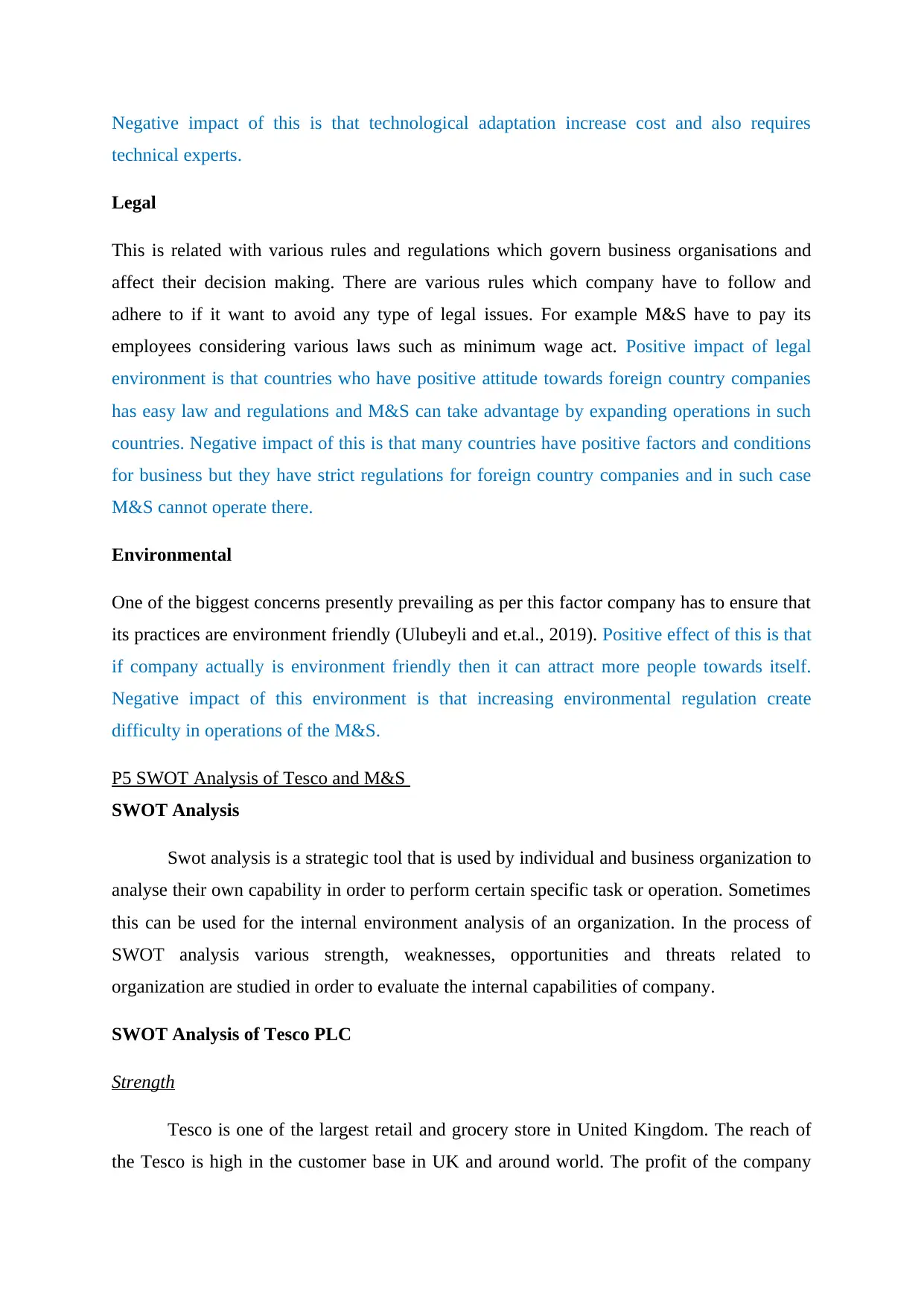
Negative impact of this is that technological adaptation increase cost and also requires
technical experts.
Legal
This is related with various rules and regulations which govern business organisations and
affect their decision making. There are various rules which company have to follow and
adhere to if it want to avoid any type of legal issues. For example M&S have to pay its
employees considering various laws such as minimum wage act. Positive impact of legal
environment is that countries who have positive attitude towards foreign country companies
has easy law and regulations and M&S can take advantage by expanding operations in such
countries. Negative impact of this is that many countries have positive factors and conditions
for business but they have strict regulations for foreign country companies and in such case
M&S cannot operate there.
Environmental
One of the biggest concerns presently prevailing as per this factor company has to ensure that
its practices are environment friendly (Ulubeyli and et.al., 2019). Positive effect of this is that
if company actually is environment friendly then it can attract more people towards itself.
Negative impact of this environment is that increasing environmental regulation create
difficulty in operations of the M&S.
P5 SWOT Analysis of Tesco and M&S
SWOT Analysis
Swot analysis is a strategic tool that is used by individual and business organization to
analyse their own capability in order to perform certain specific task or operation. Sometimes
this can be used for the internal environment analysis of an organization. In the process of
SWOT analysis various strength, weaknesses, opportunities and threats related to
organization are studied in order to evaluate the internal capabilities of company.
SWOT Analysis of Tesco PLC
Strength
Tesco is one of the largest retail and grocery store in United Kingdom. The reach of
the Tesco is high in the customer base in UK and around world. The profit of the company
technical experts.
Legal
This is related with various rules and regulations which govern business organisations and
affect their decision making. There are various rules which company have to follow and
adhere to if it want to avoid any type of legal issues. For example M&S have to pay its
employees considering various laws such as minimum wage act. Positive impact of legal
environment is that countries who have positive attitude towards foreign country companies
has easy law and regulations and M&S can take advantage by expanding operations in such
countries. Negative impact of this is that many countries have positive factors and conditions
for business but they have strict regulations for foreign country companies and in such case
M&S cannot operate there.
Environmental
One of the biggest concerns presently prevailing as per this factor company has to ensure that
its practices are environment friendly (Ulubeyli and et.al., 2019). Positive effect of this is that
if company actually is environment friendly then it can attract more people towards itself.
Negative impact of this environment is that increasing environmental regulation create
difficulty in operations of the M&S.
P5 SWOT Analysis of Tesco and M&S
SWOT Analysis
Swot analysis is a strategic tool that is used by individual and business organization to
analyse their own capability in order to perform certain specific task or operation. Sometimes
this can be used for the internal environment analysis of an organization. In the process of
SWOT analysis various strength, weaknesses, opportunities and threats related to
organization are studied in order to evaluate the internal capabilities of company.
SWOT Analysis of Tesco PLC
Strength
Tesco is one of the largest retail and grocery store in United Kingdom. The reach of
the Tesco is high in the customer base in UK and around world. The profit of the company
⊘ This is a preview!⊘
Do you want full access?
Subscribe today to unlock all pages.

Trusted by 1+ million students worldwide
1 out of 18
Related Documents
Your All-in-One AI-Powered Toolkit for Academic Success.
+13062052269
info@desklib.com
Available 24*7 on WhatsApp / Email
![[object Object]](/_next/static/media/star-bottom.7253800d.svg)
Unlock your academic potential
Copyright © 2020–2025 A2Z Services. All Rights Reserved. Developed and managed by ZUCOL.





